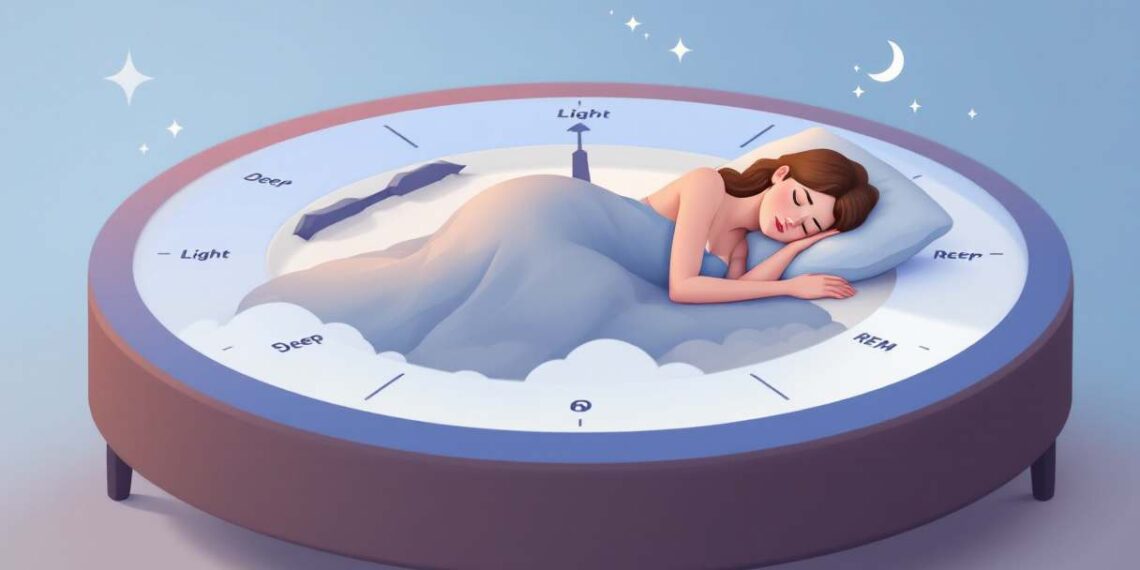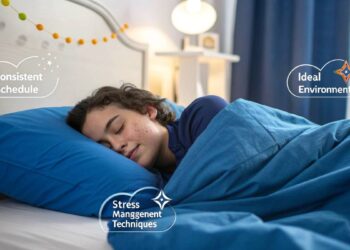Ever wondered why some mornings you bounce out of bed like a superhero, while others feel like you’ve been hit by a truck? The secret lies in the fascinating world of sleep cycles. Buckle up, sleepyhead, as we dive into the rhythm of your nightly adventure – a journey that could revolutionize the way you snooze and supercharge your days. From light dozes to deep dives and dream-filled escapades, understanding your sleep cycle is like having a backstage pass to the most important show of your life – the one that plays out behind your eyelids every single night.
Understanding the Sleep Cycle
Getting a good night’s rest isn’t just about hitting the sack at a decent hour; it’s about knowing your sleep cycles inside out. These cycles are made up of different stages, each playing its own part in making sure you wake up feeling like a rock star.
Introduction to Sleep Cycles
Picture sleep cycles like a playlist of tunes, ranging from lullabies to heavy metal jams (okay, maybe not literally). Each set typically runs about an hour and a half and splits into non-REM and REM slots. In a full night’s sleep, an adult takes this bedtime journey four to six times, depending on how long they snooze.
| Sleep Cycle | Duration (minutes) |
|---|---|
| Cycle 1 | 90 |
| Cycle 2 | 90 |
| Cycle 3 | 90 |
| Cycle 4 | 90 |
| Cycle 5 | 90 |
Every stage, whether light, deep, or dreaming, grabs its own spotlight—think memory saving, mood balancing, and body rebooting.
The 90-Minute Sleep Cycle Explained
Why should the 90-minute sleep cycle matter? Well, it’s up there with stuff like paydays and morning coffee for adults, students, parents, and night shift warriors. Get it right, and waking up might just feel like a breeze, rather than a groggy stumble.
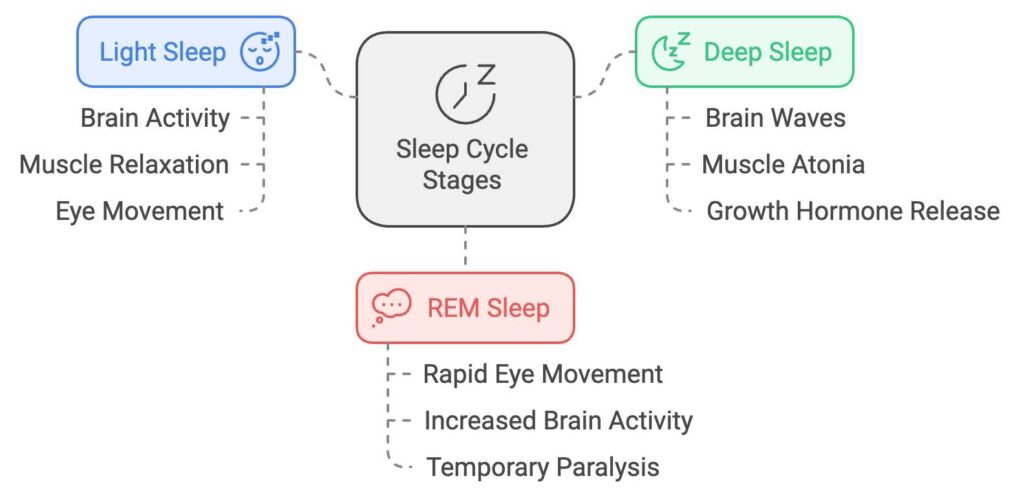
Light Sleep: Picture this phase as the gentle start to your sleep playlist. Here, your muscles chill and your heart eases up—a prelude before the deep sleeper jams start.
Deep Sleep: Now, we’re talking heavy-duty nap time. This is prime time for fixing up your body and keeping those pesky colds at bay. The tissue gets rebuilt; and batteries recharge.
REM Sleep: Dream central, folks. This is where your brain files away the day’s happenings and makes room for whatever’s coming next. It also stretches as the night ticks on.
“Sleep is the best meditation.” – Dalai Lama
People should try waking up as one of these 90-minute acts closes for an easier rise and shine. For those wanting to play around with their sleep scores, gadgets like a best bedtime calculator assist in pinpointing golden sleep windows tailored to you.
Listening to your sleep’s natural rhythm can pump up your day game, making you sharper and happier. And if you’re into routines, weaving in habits that sync with these cycles might just become the secret sauce—things like keeping consistent sleep hours or ticking off an evening routine checklist before lights out.
Benefits of Nailing 90-Minute Sleep Sessions
Getting the lowdown on the 90-minute sleep ride can jazz up your life big time, especially if you’re juggling work, cats, and kids. Catching onto these snooze benefits makes way for some serious upgrades in how you roll through the day.
“The amount of sleep required by the average person is five minutes more.” – Wilson Mizner
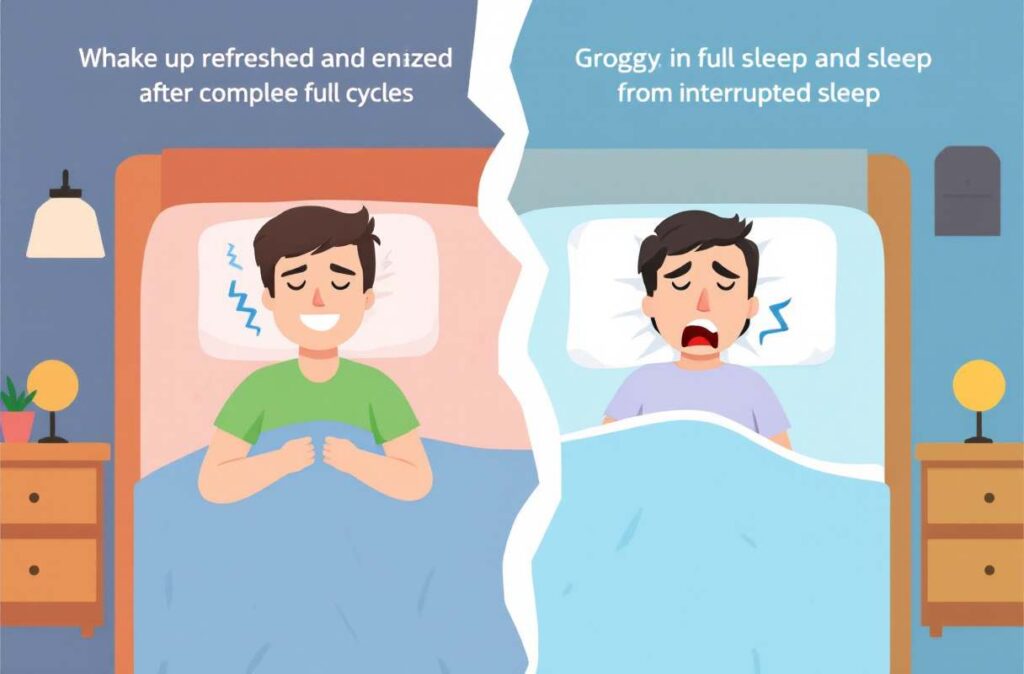
Getting That Sweet Zzz Quality
Hooking into 90-minute sleep sessions gives your brain the VIP treatment it needs. Each session is like a chill mixtape featuring light snoozes, deep dives, and REM wonders, giving you that stop-snapping-at-your-coworkers kind of rest. Plopping awake right at the end of one of these gets you all bright-eyed and bushy-tailed. A little help from a dope bedtime calculator could up your snooze game.
| Sleep Phase | Ballpark Time |
|---|---|
| Light Snooze | 5 – 10 mins |
| Deep Dive | 20 – 25 mins |
| REM Magic | 20 – 25 mins |
| Total Session | 90 mins |
Pop up after a full session and you’re more likely to feel ready to crush whatever’s on your calendar.
Powering Up Rest and Recharge
Hitting prime recovery needs solid snooze time. Those trusty 90-minute sleep jams give your body and brain a recharge. Deep snoozin’ handles muscle revamps, bone buffing, and growth sprees, while REM works its magic on your thinker – boosting memory and cooking up creativity.
| Snooze Phase | Good Stuff |
|---|---|
| Light Snooze | Getting prepped for the big stuff |
| Deep Dive | Patch up muscles, supercharge your immune shield, and get hormones to chill out |
| REM Magic | Turn memories into well-remembered yarns, sort those feels |
Relying on solid sleep tips? They’re like the secret marinade for better snoozing. Sticking to a sleep schedule religiously and following a cool-down routine make your days less cluttered, whether you’re running a circus at home or racking your brain over exams.
Hitting those 90-minute sleep cycles not only gives you bounce in your step but also boosts your get-up-and-go so you’re prepped for facing whatever the day decides to throw your way.
Understanding the Sleep Stages
Gettin’ the hang of sleep stages can make a big difference in how fresh you feel. Sleep has two main acts: REM and non-REM. Each bit does something different to keep you healthy and feeling good.
REM Sleep
REM (Rapid Eye Movement) sleep rolls around about an hour and a half after you hit the hay, and it’s awesome for brain stuff. This is when the brain’s buzzin’ with activity, so dreams can get real wild. REM’s the superstar for sorting memories, keeping emotions in check, and cracking tricky problems.
| Feature | Description |
|---|---|
| Duration | Roughly a quarter of your shut-eye time |
| Brain Activity | High, like you’re awake but not quite |
| Physical Response | Heart’s racin’, breathin’ can change up |
| Benefits | Boosts memory, learning, and keeps your mood in a floaty place |
You’ll cycle through REM a good few times overnight, making it a must-have for waking up ready to roll.
Non-REM Sleep
Non-REM sleep’s got its own gig with three acts (N1, N2, and N3), gobbling up most of your sleep. Each bit’s got its own thing going on:
| Stage | Duration | Features and Benefits |
|---|---|---|
| N1 (Light Sleep) | Quick 1-7 minutes | You’re just drifting off; easy to wake up |
| N2 (Light Sleep) | 10-25 minutes | Body cools down, heart takes a chill; gearing up for the deep dive |
| N3 (Deep Sleep) | 20-40 minutes | Crucial for mending and recharging; body fixes itself, tissues get a tune-up |
Non-REM is like charging your inner battery, letting your body fix itself so you’re ready for whatever’s next. Stages N2 and N3 are total MVPs for getting your energy back and keeping you on top of things.
Knowing these stages can dial up your snooze skills. Aiming for a solid 90-minute cycle mixing both REM and non-REM sleep helps everyone—be it night owls or busy bees—create snooze setups that work like a charm. Want tips on bedtime and wake-up rituals? Check out our guides on making a bedtime routine and morning routines that rock.
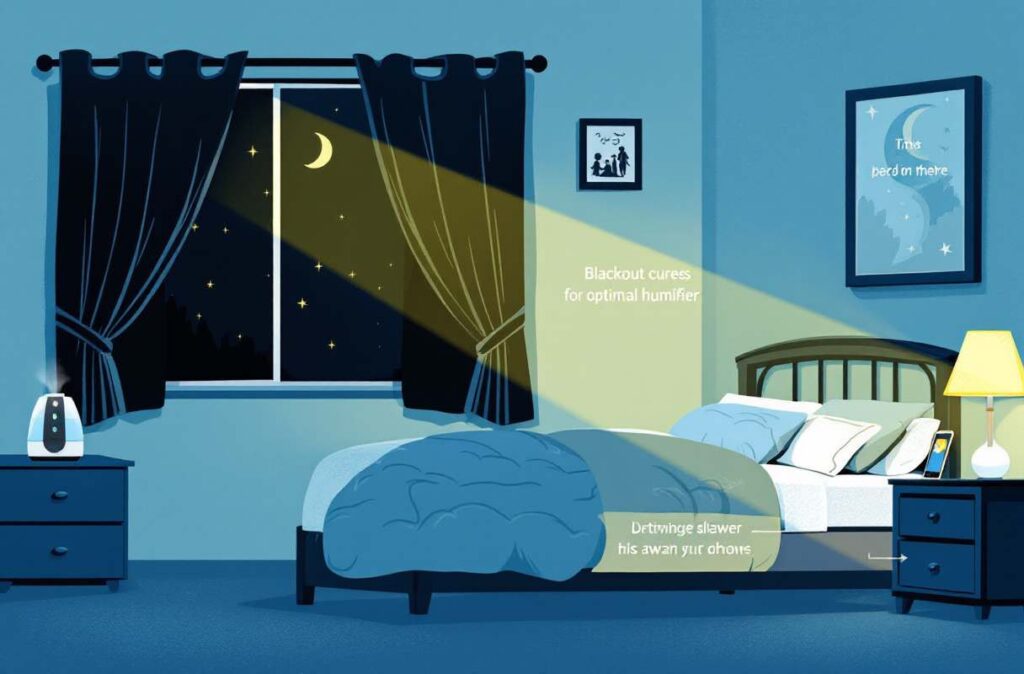
Tips for Making the Most of Your 90-Minute Sleep Cycle
Leveraging the magic of a 90-minute sleep cycle can boost your snooze quality and leave you feeling refreshed. Here’s a no-nonsense guide to help you get there.
Locking In a Steady Sleep Routine
Getting set with a regular sleep timetable works wonders for that 90-minute cycle. Hitting the hay and popping up from it at the same time keeps your body clock in check. The perks of a steady schedule make sticking to it worth your while.
| Perks | What it Does |
|---|---|
| Better Sleep Quality | Keeps you in sync for easier snoozing. |
| More Zing in Your Step | Cuts down on that dragging feeling. |
| Fuss-Free Mornings | Helps you rise and shine naturally. |
Check out our piece on clockwork sleep benefits to learn more.
Setting the Mood for Sleep
Evenings should be chill. Try reading, a bit of meditation, or a soak in the tub to signal bedtime’s near. Avoid screens before you hit the sack. Our article on screen-free bedtime shenanigans has more tips on winding down.
Crafting a Sleep-Friendly Nest
Where you sleep matters big time. Aim for the right room temp, keep noise in check, and get those lights dimmed.
| Part of Your Nook | Suggestions |
|---|---|
| Feel the Chill | Keep it cool—a sweet 60-67°F feels good. |
| Muffle the Noise | Earplugs or white noise are your pals. |
| Dim the Lights | Blackout curtains can make all the diff. |
A cozy sleep pad amps up your 90-minute cycle effects.
Timing Nap Power Plays
Naps are like mini reboots for the day. Aim for 20-30 minutes to avoid deeper sleep, which can make ya groggy later.
| Quick Snooze Time | What It Delivers |
|---|---|
| 20-30 minutes | Perks up mood and sharpens focus. |
| 60 minutes | A full cycle, but waking may feel swampy. |
Check out our go-to guide on nap like a champ for a full scoop.
Smart Tech Usage
Tech can be a double-edged sword in sleep matters. Use apps and gadgets to your gain—track your Zs or set an inviting sleepy-time scene.
Sleep routine apps can help manage sleep plans and nudge you to start your bedtime rituals. Dive into our collection of top sleep routine apps for ideas to keep your sleep on track.
With these smart steps, you’re on the path to nailing those 90-minute sleep cycles for superior sleep and brighter days.
Lifestyle Factors Impacting Your Sleep
Getting the most out of that snooze is about more than just hitting the hay. Dive into the game-changers like moving your body, watching what you munch and sip, and chilling out with stress-busting know-how.
Exercise and Physical Activity
Workouts aren’t just for building biceps; they’re your ticket to dreamland. Gentle exercise helps tuck you in faster and makes those Zzz’s deeper.
| Type of Exercise | Duration | How Often You Should Do It |
|---|---|---|
| Aerobic Exercise | 30 minutes | 3-5 times a week |
| Strength Training | 20-30 minutes | 2-3 times a week |
| Stretching or Yoga | 10-15 minutes | Daily |
Pumping the iron too close to lights out can keep you too wired to sleep. Morning runners or afternoon gym-goers sleep tighter. Need more on optimal timing? Have a gander at our article on best time to exercise for sleep.
Nutrition and Hydration
What you chow down on and drink fills your sleep bank. A well-juggled diet and the right bites can help mellow you out before bed.
| Nutrient | Sources | Good Bedtime Effects |
|---|---|---|
| Magnesium | Nuts, seeds, leafy greens | Unknots tense muscles |
| Tryptophan | Turkey, yogurt, bananas | Boosts serotonin, the happy hormone |
| Hydration | Water, herbal teas | Keeps slumber pee-break free |
Steer clear of caffeine and cocktail hour close to bedtime. Joe can mess with your sleep cycle, and liquor, though it might knock you out, can lead to lousy sleep. Want to sip smarter before bed? Peek at our piece on best teas for your bedtime routine.
Stress Management Techniques
Keeping stress at bay is the secret key to sound sleep. High-stress levels are like a bad roommate, messing with both falling asleep and staying there. Find your calm and create a space ripe for rest with these tricks.
| Technique | What’s it About? | How Often to Chill |
|---|---|---|
| Meditation | Tunes into breathing and being | Daily, 5-10 minutes |
| Deep Breathing | Focused breaths to center you | Whenever stressed, especially before bed |
| Journaling | Jots down the voices in your head | Right before hitting the sack |
Adding these zen habits at night can turn your sleep around. For a how-to on winding down right, explore our guide to creating a bedtime routine.
By using exercise, eating smart, and managing stress, you can seriously boost your sleep quality and be a champ at riding those 90-minute sleep cycles. Sleep tight!
Strategies for Unpredictable Schedules
When life throws your schedule out of whack, getting good sleep can feel like chasing down a unicorn. But fear not — a few clever strategies can help you catch some quality Z’s.
Juggling Shift Work
If your job’s got you clocking shifts like they’re going out of style, you know keeping a steady sleep routine is like wrestling a cat into a bath. But worry not — here’s how you can show sleep who’s boss:
| Trick | What It’s All About |
|---|---|
| Keep it Regular | Do your best to hit the hay and rise from the haystack at the same time every day, weekends included. Your body’s internal timer gives a big fat thumbs up to this. |
| Craft a Sleep Zone | Turn your sleeping chamber into a sweet sanctuary. Think of blackout curtains and noise-canceling gadgets. Sweet dreams are made here. |
| Tame the Light Beast | Be choosy about when you see the bright lights. After a night shift, throw on those reverse vampire shades to avoid sunrise. Need more tricks like this? Peep our guide on creating a digital sunset routine. |
| Nappin’ Game Strong | Squeeze in quick naps, lasting 20-30 minutes, to get through your next clock-in. These snoozes perk you up without messing with nighttime slumber. Master the art with our power nap tips. |
Acing the Study-Sleep Balancing Act
School’s a real balancing act between books and beds. But who says you can’t ace ‘em both with a little planning?
| Plan | What’s the Deal |
|---|---|
| Sleep Like You Mean It | Pencil in those zzz’s just like you would cram sessions. Your noggin needs sleep to remember what you studied and to keep thinking on point. |
| Bedtime Math | Dive into the magic of bedtime calculators for tailored sleep and wake times that match your natural rhythm. |
| Study Smart | Break those books into smaller gigs with breathers in-between to keep burnout at bay. Try our evening routine checklist to wind down the right way before sleep. |
| Curb the Screen Glow | Put down that phone or tablet 30-60 minutes before hitting the sack. Chill out with screen-free bedtime fun to switch gears before snoozing. |
It’s totally possible to make sleep work with life’s rollercoaster if you’ve got the right moves. Shift workers or students — no matter your schedule woes — can still rock the sleep cycle and soak up its benefits with these strategies.
Family Sleep Routines
Getting everyone in the family to sleep well is like discovering an endless stash of gold. It’s all about figuring out what each little night owl (or early bird) needs and setting up cozy, calm places for them to snooze. Let’s break it down.
Children’s Sleep Needs
Kids need different amounts of sleep based on their stage in life. Here’s a general idea of how many Zs they should be catching:
| Age Group | Recommended Zzz (hours) |
|---|---|
| Newborns (0-3 months) | 14-17 |
| Infants (4-11 months) | 12-15 |
| Toddlers (1-2 years) | 11-14 |
| Preschoolers (3-5 years) | 10-13 |
| School-age (6-13 years) | 9-11 |
| Teenagers (14-17 years) | 8-10 |
Helping kids stick to a regular schedule makes bedtime less of a fight. Once you get the hang of it, you can whip up a bedtime routine that might involve calming rituals like storytime or bath time. Especially for teenagers juggling homework, friends, and other chaos, pushing good sleep habits can make the world of difference.
Creating a Calm Sleep Environment
For a peaceful night’s rest, setting up a comfy and calming sleep spot is key. So, what’s the secret formula for an inviting sleep space?
- Darkness: Blackout curtains are your friend. Think of them as the ultimate light blockers that help signal it’s shut-eye time.
- Comfortable Temperature: Keep it cool—around 60-67°F. This is the sweet spot for most folks.
- Minimized Noise: A white noise machine or soft tunes can cover up those distracting nighttime sounds.
| Environmental Factor | Chill Approach |
|---|---|
| Light | Blackout curtains |
| Temperature | Cool temps (60-67°F) |
| Noise | White noise or soft music |
Unplugging from screens a bit before bedtime can ease everyone into a restful state. Ditching the electronics for screen-free bedtime activities not only means more family fun but also sets up the perfect backdrop for snoring until morning. With a serene bedroom setup, the magic of that 90-minute sleep cycle starts working wonders for everyone.
Conclusion
As we’ve unraveled the mysteries of the sleep cycle, it’s clear that quality shut-eye is more than just a numbers game. It’s a finely tuned orchestra of light snoozes, deep dives, and REM revelries, each playing its part in your nightly restoration. By embracing the 90-minute rhythm, creating sleep-friendly environments, and adapting to life’s curveballs – whether you’re burning the midnight oil or juggling family bedtimes – you’re not just improving your sleep; you’re unlocking a superpower. So tonight, as you drift off, remember: you’re not just sleeping, you’re conducting a symphony of renewal. Sweet dreams, and may your mornings be as bright as your newfound sleep wisdom!
FAQs
What is a sleep cycle?
A sleep cycle is a 90-minute period during which your body progresses through different stages of sleep, including light sleep, deep sleep, and REM sleep.
How many sleep cycles should I aim for each night?
Aim for 4-6 complete sleep cycles per night, which translates to about 6-9 hours of sleep for most adults.
What happens if I wake up in the middle of a sleep cycle?
Waking up mid-cycle can leave you feeling groggy and disoriented. Try to time your wake-up for the end of a cycle for optimal alertness.
Can naps follow the 90-minute cycle rule?
Yes, a 90-minute nap can include a full sleep cycle, but shorter power naps of 20-30 minutes are often more refreshing and less likely to interfere with nighttime sleep.
How can I improve my sleep quality?
Establish a consistent sleep schedule, create a relaxing bedtime routine, optimize your sleep environment, manage stress, and be mindful of diet and exercise habits.
Additional resources
National Sleep Foundation: Sleep Cycles and Stages
Sleep.org: Understanding Sleep Cycles
Mayo Clinic: Sleep tips: 6 steps to better sleep
American Academy of Sleep Medicine: Healthy Sleep Habits

